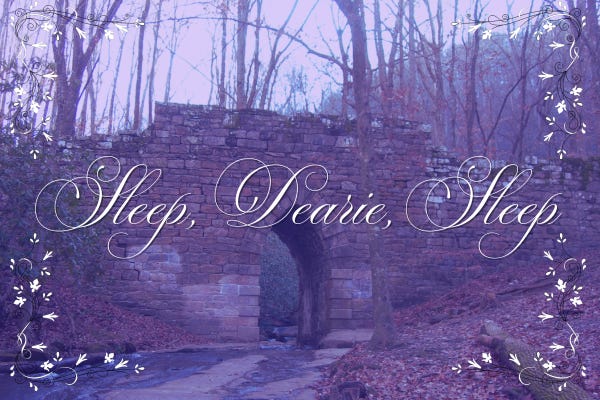
I hope you enjoyed Sleep, Dearie, Sleep! If you haven’t read it yet, you should be aware that this post contains spoilers. If you want to read the novella first, start here.
This story was a bit of a departure for me. The idea of writing historical fiction has always intimidated me. It involved a lot more research than I’m used to, and I did my best to stay true to the period and avoid anachronistic idioms or patterns of speech. I also knew from the start that this story could only be written in an epistolary and journal format, which was also intimidating. It meant immersing myself in the minds of the characters to get their voices right, an exercise that proved emotionally taxing, to say the least. But it was worth it if I pulled it off.
I confess that I cheated a bit. Having read Diana Gibaldon’s Outlander series a couple of times through, I felt like I was on fairly comfortable ground depicting late 18th century Scots settlers in the Carolinas. That worked out well for a number of reasons. For one, I was able to bring in Celtic beliefs and traditions, and for another, that region boasts a historic bridge that is very similar to the fictional bridge I envisioned for my story — more on that later.
What inspired the story?
In the chat,
— an excellent writer of historical horror in her own right; you should click on her name and check her out — asked, “Where did you first get the idea for this story?” I’m glad she did, because that’s precisely what I wanted to share with you.Early last year, I was led to read The Threshold Covenant by H. Clay Trumbull. I wrote about that last year in this post, focusing on the theological implications, but here’s the bit that’s relevant to give you some background:
In this book, he compiled research showing how, in every culture and every age throughout human history, archaeologists and anthropologists have found evidence of this practice of treating the doorway, or threshold, of the home as an altar to the deity that's worshipped within the household. When welcoming someone into the household, a sacrifice -- often animal, sometimes salt or wine in place of an animal; sometimes, in some cultures, human -- would be made at the threshold altar, and as the person being welcomed stepped over the blood on the threshold, they entered into a covenant where, as long as they remained under that roof, they would be treated a family and protected by the household deity or deities. This practice was usually part of marriage rites, as well, with the new bride being welcomed into the household and covenanted to be part of the family.
Throughout the ages, this practice took on a lot of different forms, and grew from the threshold of the home to the threshold of the temple or place of corporate worship, the entrance to the community, the gate to the city, even the borders of the nation. We still see vestiges of this ancient practice alive today in the traditions of carrying a bride over the threshold of her new home, or christening a new ship by spilling the "blood of the grape" on its bow. This isn't mentioned in the book, but I also suspect that the phrase "rolling out the red carpet" comes from this practice.
In a chapter titled “Laying the Foundations in Blood,” Trumbull recounts several legends of bridges refusing to be built without the offering of a human sacrifice. Three such legends, in particular, served as inspiration for this story:
Popular ballads give other indications of such customs, in various lands. “In a song, of which there are several versions, of the building of the bridge of Arta, it is told how the bridge fell down as fast as it was built, until at last the master-builder dreamed a dream that it would only stand if his own wife were buried alive in the foundations. He therefore sends for her, bidding her dress in festival attire, and then finds an excuse to make her descend into the central pile, whereupon they heap the earth over her, and thus the bridge stands fast.”[
H. Clay Trumbull. pg49216-images-3 (p. 52). (Function). Kindle Edition.
A story told among the Danes is, that “many years ago, when the ramparts were being raised round Copenhagen, the wall always sank, so that it was not possible to get it to stand firm. They therefore took a little innocent girl, placed her in a chair by a table, and gave her playthings and sweetmeats. While she thus sat enjoying herself, twelve masons built an arch over her, which, when completed, they covered with earth to the sound of drums and trumpets. By this process the walls were made solid.”[131]
“Thuringian legend declares that to make the castle of Liebenstein fast and impregnable, a child was bought for hard money of its mother, and walled in. It was eating a cake while the masons were at work, the story goes, and it cried, ‘Mother, I see thee still;’ then later, ‘Mother, I see thee a little still;’ and as they put in the last stone, ‘Mother, now I see thee no more.’”[132]
As if that’s not horrific enough, apparently in Easter Europe they weren’t above resorting to abducting random children to serve as their sacrifices:
A similar story is told of a Slavic town on the Danube. A plague devastated it, and it was determined to build it anew, with a new citadel. “Acting on the advice of their wisest men, they sent out messengers before sunrise one morning in all directions, with orders to seize upon the first living creature they should meet. The victim proved to be a child (Dyetina, archaic form of Ditya), who was buried alive under the foundation-stone of the new citadel. The city was on that account called Dyetinets [or Detinetz], a name since applied to any citadel.”[133] It is even said that “when, a few years ago, the Bridge Gate of the Bremen city walls was demolished, the skeleton of a child
H. Clay Trumbull. pg49216-images-3 (pp. 49-50). (Function). Kindle Edition.
Scotland was no stranger to this practice, either:
A Scottish legend tells that St. Columba found himself unable to build a cathedral on the island of Iona unless he would secure its stability and safety by the blood of a human sacrifice. Thereupon he took his companion, Oran, and buried him alive at the foundations of the structure, having no trouble after that.[135]
H. Clay Trumbull. pg49216-images-3 (p. 50). (Function). Kindle Edition.
Lest you think these merely legends with no basis in truth…
And it is said that under the walls of the only two round towers of the ancient Irish examined, human skeletons were found buried.[136]
H. Clay Trumbull. pg49216-images-3 (p. 50). (Function). Kindle Edition.
You might think that this is an ancient practice, but maybe not so much (warning - this description is graphic):
Until the transfer of Alaska to the United States, in 1867, by the Russian government, human sacrifices at the foundation of a new house were common in that portion of America. The ceremonies are thus described by one familiar with them: “The rectangular space for the building is ... cleared, a spot for the fireplace designated, and four holes dug, wherein the corner posts are to be set.... A slave, either man or woman who has been captured in war or is even a descendant of such a slave, is blindfolded and compelled to lie down face uppermost, in the place selected for the fireplace [the site of the domestic altar]. A sapling is then cut, laid across the throat of the slave, and, at a given signal, the two nearest relatives of the host sit upon the respective ends of the sapling, thereby choking the unhappy wretch to death. But the corner posts must receive their baptism; so four slaves are blindfolded, and one is forced to stand in each post-hole, when, at a given signal, a blow on the forehead is dealt with a peculiar club ornamented with the host’s coat of arms.” It is said that even to the present time [Note from Jean: this book was published in 1896], on the building of a house in Alaska, “the same ceremonies are enacted, with the exception of the sacrifices, which are prevented by the United States authorities.”
H. Clay Trumbull. pg49216-images-3 (pp. 50-51). (Function). Kindle Edition.
As haunting as all of these accounts are, it was the stories about the little girls, and the Greek builder sacrificing his own wife, that lingered in my imagination and formed the foundation of Sleep, Dearie. On the surface, it simply seemed like a good, if sad and gruesome, basis for a gothic horror story. But the more I thought about it, the more I felt a need to understand how a man could arrive at a place where it seems reasonable to sacrifice a loved one, or even a strange child, for the purposes of finishing a heckin’ bridge of all things. Not that understanding excuses or absolves such a thing. I just needed to wrap my mind around it.
Other Sources of Inspiration
Other threads of inspiration presented themselves as I did research for the story. White House architect James Hoban seemed like an ideal figure to pull in to provide a grounding in historicity. As far as I know, Mr. Hoban was an upstanding citizen who never engaged in human sacrifice, child or otherwise. He was, however, a low-level Freemason. Whether you believe it to be truth or mere conspiracy theory, the Freemasons are reputed to be up to a lot of shadiness. But it’s also thought likely that it’s the top tier of degree holders who are generally up to no good, whereas lower-tier members tend to be kept in the dark. Of course, it seemed natural that Archie would himself be a Freemason, being both a Scot and a builder.
In my research I also stumbled across the Poinsett Bridge (the bridge in the photo gracing the top of the page), which is the actual oldest bridge in the South, constructed in 1820 and as far as I know did NOT involve any human sacrifice. Interestingly enough, however, it’s believed that it was most likely designed and built by Robert Mills, who designed the Washington Monument. IYKYK.
Another major inspiration that carried throughout this story was the Divine Council Worldview — my Biblical belief and understanding that supernatural forces, both good and evil, are very real and alive and interacting with the natural world on a regular basis. The nutshell version is that the ancient pagan gods are in fact fallen angelic entities in rebellion against the true Creator God. Archie is a man who grew up with one foot in both worlds — raised a Christian, but also steeped in ancient pagan traditions by virtue of being a Celt.
But Archie was also steeped in the religion of Enlightenment, which elevates human reason and achievement, along with earthly reward, and relegates the old gods and devils to mere superstition. While all of Trumbull’s examples of human and child sacrifice took place in the Old World, I wanted to explore this idea of human progress clashing with the ancient gods and their hunger for recognition and worship — and also to show that the gods of the New World are every bit as bloodthirsty as those of the Old World (just look at all the blood that was spilt in the founding and expansion of this nation).
From Concept to Execution
Leigh also asked, “Is the finished product similar to your original concept, or has it changed significantly?”
That’s a great question. I knew from the beginning that it needed to be historical and epistolary. It took a long time to decide both where and when to set it. My first thought was to set it somewhere in Europe in the 1600s, but that felt out of my depth.
As I wrestled with this decision, I dove into the first epistolary gothic horror novel that came to mind — Dracula. Although that’s set in the late Victorian era, I still feel like it gave me a good foundation. After that I spent months reading gothic and chthonic horror, including the writings of Algernon Blackwood and William Hope Hodgson, and although those are set in the late 19th and early 20th centuries, they were still informative and inspirational.
I finally settled on the late 18th or early 19th century because I felt I’d be better able to capture voices from that time. Like I already said, I leaned heavily on Outlander to capture the voice of the late 18th century (though Billy Boyd provided the voice of Archie in my head as I wrote, thanks to having recently rewatched LotR for the umpteenth time).
But while the setting changed from what I first imagined, I think ultimately I managed to capture what I originally set out to — an architect driven by internal and external pressure to sacrifice his own child, his wife being driven to madness and suicide as a result, and him being haunted by the both of them.
Soundtrack
Music did a lot to keep me in the proper headspace to write this story. Of course, Bear McCeary’s Outlander soundtrack got the most play, especially the seasons that are set in North Carolina, with their mix of Celtic and Appalachian folk music and vaguely supernatural vibes.
Loreena McKennitt also brought that slightly spooky Celtic vibe.
And this dark fairy ambient music set the mood for the scene where Archie walks along the river bank ahead of the winter storm and makes his first tentative prayer to the old gods of the forest.
And that’s a wrap! Within the next couple of months, I hope to release the entire story in both e-book and paperback form, and I’ll be sure to let you know when I do.
In the meantime, after a brief hiatus, I’ll be moving on to my next serial fiction project — the continuation of Flesh and Blood.
Until next time!
♥️ Jean










Thanks for the shout-out and for answering my questions! I always enjoy hearing about the process and inspiration behind a story. 😊
It was SO, SO good! I really loved it and this post. Reading the backstory behind the story is fascinating, especially when I'm not knowledgeable about the topic explored (which I wasn't and am horrified by).
The blood on the doorpost or in the doorway reminds me of Passover. And also how the Israelites were supposed to put God's word around their doorposts and gates, bind them onto their hands, and wear them on their foreheads. (Deuteronomy 6:8-9 for anyone interested). I wonder if either of these had to do with the (awful) practices at the time of sacrificing a person and using their blood on the doorpost/doorway.
Very interesting post, Jean. I've made my way through almost all of your novellas now because I found you here and read Sleep, Dearie, Sleep. :)